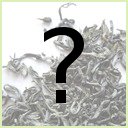Yerba Maté
Wikipedia: Yerba_mate | Teaviews: mate-teaLast Updated: Mar. 19, 2014
↑About Yerba Maté
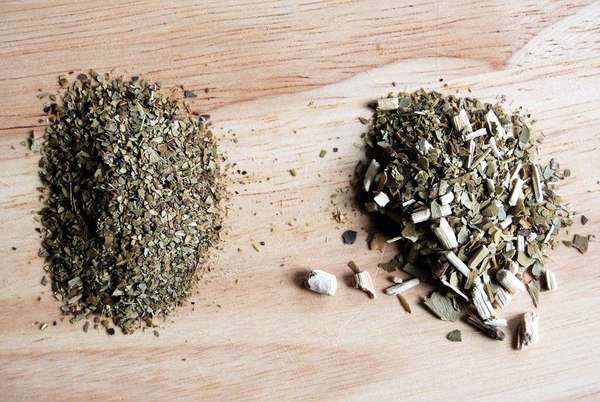 Two different grades of green, unroasted Yerba Mate. Photo © Mariano-J (Wikimedia Commons), CC BY-SA 3.0.
Two different grades of green, unroasted Yerba Mate. Photo © Mariano-J (Wikimedia Commons), CC BY-SA 3.0.Yerba maté is made from a species of holly, Ilex paraguariensis, and is one of several species of holly that naturally contain caffeine, others being guayusa and yaupon. In addition to caffeine, yerba maté contains other chemicals that make its effects somewhat different from those of tea or coffee. Because yerba maté is prepared similarly to tea, the drink made from it is often referred to as mate tea or yerba mate tea.
There is a lot of variability in the form and processing of Yerba maté, including the portion of stem, leaf, and dust included, whether it is green or roasted, whether or not it has been smoked or unsmoked during drying, and the degree to which it has been aged.
Flavored yerba mate
On RateTea we list only pure mate in this category. Blends containing mate among flavorings or other ingredients are classified as flavored yerba maté, unless they also contain tea, in which case they are classified as miscellaneous blends. Common flavorings include spices, often leading to the creation of "mate chai" or "chai mate" blends, a reference to masala chai or spiced tea.Cultivation and production
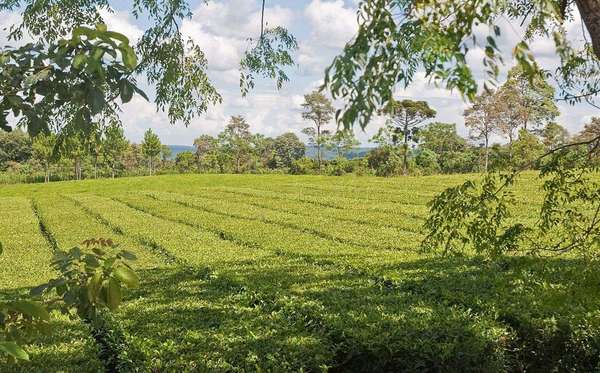 Yerba Mate Plantation in Misiones, Argentina, Photo © Phillip Capper from Wellington, New Zealand, CC BY 2.0.
Yerba Mate Plantation in Misiones, Argentina, Photo © Phillip Capper from Wellington, New Zealand, CC BY 2.0.Mate production contains many steps, some of which are necessary, but others of which are sometimes omitted and lead to different finished forms. Mate is gathered and then briefly blanched over a fire, to stop the natural oxidation that occurs in the leaf, making its production somewhat analagous to green tea, more similar to pan-fired or baked Chinese green teas, less so like Japanese steamed green teas.
After blanching, a second drying phase begins. This stage must be thorough, as the leaf is poisonous until fully dried. Some varieties of mate are dried over wood fires, often described as smoking, a process which imparts a smoky aroma to the finished leaf.
After drying, the leaves are milled, and then the mate is left to age. The ageing usually is carried out for a minimum of six months, and sometimes for as long as two years.
Some mate is roasted, giving it a darker color, a bit like coffee. Dark-roast mate tends to be milder in flavor than coffee, often sweeter than unroasted mate, but it also has an aroma that is slightly more reminiscent of coffee, and more suggestive of cocoa or chocolate.
Traditional preparation & consumption
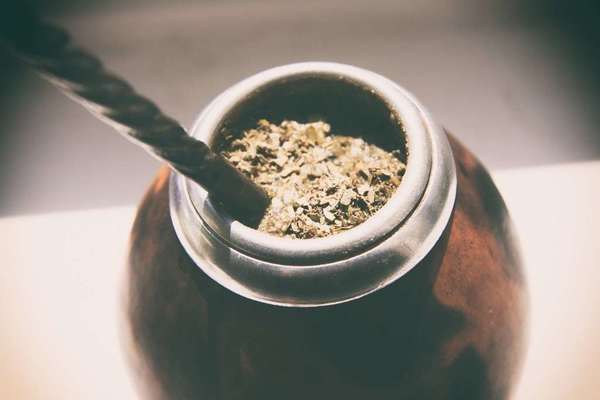 Mate served in a traditional gourd with metal straw. Photo © barnimages.com, CC BY 2.0.
Mate served in a traditional gourd with metal straw. Photo © barnimages.com, CC BY 2.0.Health effects
Yerba maté has not been as widely studied as tea, and there have been mixed results as to its health effects. It has been found to have significant antioxidant content which is likely preserved when it is consumed as tea.[1][2] It also contains vitamins and minerals, including vitamins C, B1, and B2, and phosphorus, iron, and calcium.[2]However, there is a single case report of consumption of very large amounts of Yerba mate over a long period of time being pointed to as a likely cause of liver damage.[3]
The findings on yerba maté's effects on cancer are mixed, but can be explained when looking deeper at the various studies; two reviews have concluded that drinking hot maté is probably carcinogenic to humans, but that the effect was probably caused by the fact that it was a hot beverage and was scalding the mouth and throat, not by any substance in the maté causing cancer.[2][4] Although some epidemiological studies have found substantial increases in cancer risk associated with heavy (1 liter daily) yerba maté consumption, it is not clear whether this is due to the maté, to contaminants present in the maté, or is attributable to the maté increasing absorption of harmful chemicals in tobacco or other drugs; tobacco and alcohol use were high in the groups which showed increased cancer risk.[2] Contrasting with these studies, Yerba maté has also shown strong anti-cancer activity in a number of in vitro studies.[2]
Based on this research, it makes sense to be cautious about drinking mate from a straw, being careful to sip it slowly to avoid burning the mouth and throat, to obtain yerba mate from a source known to be free of contaminants, and to avoid heavy tobacco and alcohol use if you also consume large amounts of mate. There is no evidence that moderate mate use can cause any negative health effects other than by these three mechanisms, and other research points to potential health benefits and nutritional value for this drink, possibly involving anti-cancer potential.
References:
1. Rosana Filip et. al, Antioxidant activity of Ilex paraguariensis and related species, Nutrition Research, Vol. 20, No. 10, pp. 1437-1446, Oct. 2000.
2.. C.I. Heck, E.G. De Mejia, Yerba Mate Tea (Ilex paraguariensis): A Comprehensive Review on Chemistry, Health Implications, and Technological Considerations, Journal of Food Science, Vol. 72, No. 9, Nov/Dec 2007.
3. J McGee et al.A case of veno-occlusive disease of the liver in Britain associated with herbal tea consumption., Journal of Clinical Pathology Vol. 29, pp. 788-794, 1976.
4. International Agency for Research on Cancer (IARC) - Summaries & Evaluations, Vol. 51, p. 273, 1991.
↑Recent Yerba Maté Reviews — RSS 
Aroma really has a creamy coconut note.
Flavor isn’t overly complex but hits the coconut note well. Body is fairly thick.
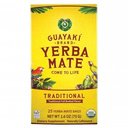
Earthy Nutty Undertones,Worth the price and time,But...may get tired if you just switched over from coffee "And for those Heath conscious" Yes, I lost Weight From it :)
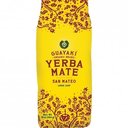
Drinking this in my gourd this morning while doing housework. Yerba Mate is one of my great loves. There is nothing like a warm gourd amigo to help me get through my day. It makes my body feel light and airy, and hums around my feet and hands. Strange, I know, but this is the only way I can properly describe it.
Tod...
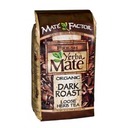
Loose Dark Roast Organic Yerba Mate from Mate Factor
Style: Yerba Maté – Region: BrazilMar. 24th, 2013
I'm not very familiar with yerba mate. It smells like a tree or something. But it tastes really good - it has a rich flavor, kind of chocolaty. I added cream and sugar.
Read Full Review
This is a decent everyday tea. It has a slight grassy aroma with a more noticeable smooth herbal flavor along with a greenish-amber coloring. A filling tea with some relaxation.
Read Full ReviewRead More Reviews of Yerba Maté (13) ...
↑Top Reviewers
| Rank | User | # | % |
| 1 | 7 | 19 | |
| 2 | 1 | 3 | |
| 3 | 1 | 3 | |
| 4 | 1 | 3 | |
| 5 | 1 | 3 |
Review 2 teas to get on this list!
Advertisement
↑Most-Rated Yerba Maté

Traditional Yerba Mate Tea Bags
| Brand: | Guayaki |
| Style: | Yerba Maté |
| Region: | Blend |
| Caffeine: | Caffeinated |
| Leaf: | Teabag |

Loose Dark Roast Organic Yerba Mate
| Brand: | Mate Factor |
| Style: | Yerba Maté |
| Region: | Brazil |
| Caffeine: | Caffeinated |
| Leaf: | Loose |

San Mateo Air Dried Loose Yerba Mate
| Brand: | Guayaki |
| Style: | Yerba Maté |
| Region: | Brazil |
| Caffeine: | Caffeinated |
| Leaf: | Loose |

Yerba Maté Shade Grown
| Brand: | Rishi Tea |
| Style: | Yerba Maté |
| Region: | Argentina |
| Caffeine: | Caffeinated |
| Leaf: | Loose |






